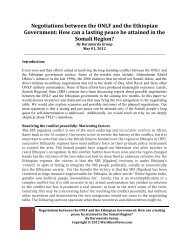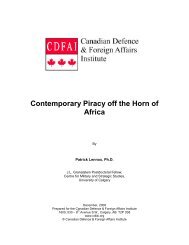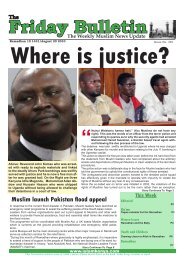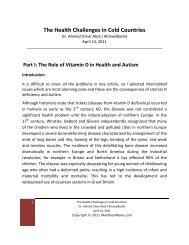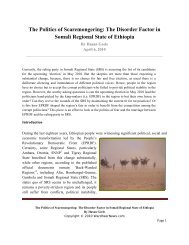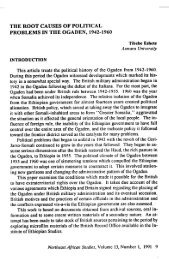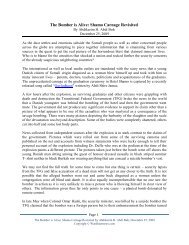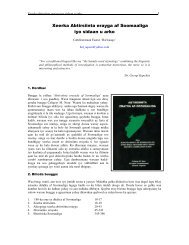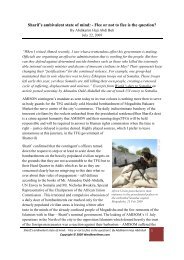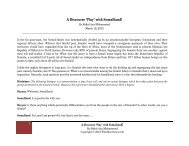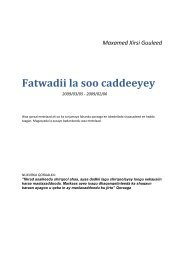View - WardheerNews
View - WardheerNews
View - WardheerNews
Create successful ePaper yourself
Turn your PDF publications into a flip-book with our unique Google optimized e-Paper software.
clan militia. This has earned them the support of their clan elders content to see an increase<br />
of their own group’s military capabilities. 38<br />
Inciting and nurturing violent conflict in order to access the region’s ‘conflict<br />
resolution’ budget line represents another manipulative tactic. Lister (2004:23) recently<br />
noted that ‘there was a widespread view (…) that some government officials benefited<br />
from the increased flow of resources to their areas brought by conflict. They thus<br />
attempted to perpetuate conflict, making “a trade on the insecurity”’. Central to this<br />
strategy was establishment of a special budget line within the regional Bureau of Security<br />
reserved to resolve clan conflicts after transfer of capital from Godey to Jigjiga in 1995.<br />
The budget line was earmarked for resolving the region’s multiple and recurrent clan<br />
conflicts and operated separately from regular finances for the regional police and militia.<br />
Whenever a major clan-based conflict erupted within the Somali Region, a delegation of<br />
senior officials (usually regional bureau heads belonging to the clans fighting) as well as<br />
clan leaders and some militia on government payroll were sent to the conflict site. Large<br />
sums of money were invoked to fund these conflict resolution trips. They usually involved<br />
several days of hospitality and qat and remained unaccounted for. The attractiveness of the<br />
conflict resolution budget line was such that it became known locally ‘the big project’.<br />
Most of the money used to ‘make peace’ effectively disappeared in the pockets of<br />
government officials, clan elders, and their local supporters. The existence of an<br />
institutionalised lump sum for ‘conflict resolution’ provided an incentive for politicians to<br />
actually fuel and create conflicts in their home areas that permitted access to such funds. 39<br />
Political denunciations and pseudo-criminal charges against party and government<br />
officials represent a recurrent device in political disputes. They are mainly used to invoke<br />
or legitimise the ousting or imprisoning of officials and seldom translate into a formal legal<br />
process involving the judiciary. Apart from general accusations such as ‘hindering<br />
development’ or ‘preventing the people of the region from enjoying the benefits of the<br />
transitional period’ (Ethiopian Herald, 9 April 1994, cited in Markakis 1996:568), two<br />
specific types of charges have proved particularly popular in justifying attacks on and<br />
dismissals of rival politicians. They are (1) accusations of corruption and mismanagement<br />
and (2) claims of supporting the ONLF, euphemistically referred to as ‘the anti-peace<br />
elements’ - nabad diid in Somali or tsere selam in Amharic. The ESDL and later the SPDP<br />
rationalized removal from office of most of the seven former regional presidents on<br />
grounds of unspecified corruption charges or being an ONLF backer. Abdillahi Mohamed<br />
Saadi and his vice-president had been arrested upon accusation of embezzling more than a<br />
19



